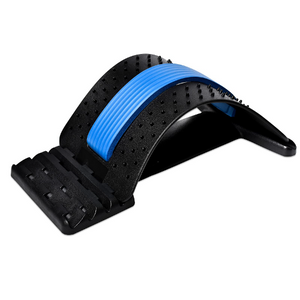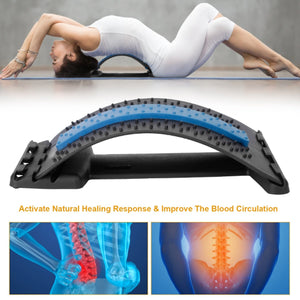To sit comfortably with SI joint pain, maintain a neutral spine position, use ergonomic chairs or cushions, and avoid slouching or crossing legs. Short, frequent sitting intervals combined with stretches and micro-movements reduce discomfort. This guide shares practical SI joint sitting tips, posture advice, and product recommendations to improve your comfort and spinal health.
Sacroiliac (SI) joint pain can significantly impact your daily routine—especially when sitting for long periods. Whether you're working at a desk or driving, improper posture can worsen the pain and limit mobility. In this guide, we’ll cover expert-backed strategies on how to sit with SI joint pain, discuss the best chairs and cushions, and share actionable tips to protect your lower back and improve long-term comfort.
What is SI Joint Pain?
Sacroiliac joint pain, or SI joint pain, is discomfort or pain in the area where the ilium (a portion of the pelvis) and sacrum (the triangle bone at the base of the spine) meet.
This joint is crucial for transferring weight and force between the upper and lower bodies when walking, running, or sitting. Pain in the thighs, hips, buttocks, or lower back may indicate mild to severe SI joint pain.
Many things, including pregnancy, arthritis, injuries, or bad posture, can cause it. If left untreated, it can impair quality of life and mobility.
Tips to Sit With SI Joint Pain and Find Relief
Here are some simple tips to help you sit comfortably and ease the discomfort of SI joint pain:
1. Employ Support
Having something to support your lower back when you're sitting is beneficial. To get it, take a seat with a pillow or towel rolled up behind your lower back.
This additional support eases the strain on your SI joint and naturally maintains your spine.
2. Sit Tall
Proper posture is more effortless when you sit up straight and rest your shoulders against the back of the chair.
Maintaining this position avoids undue strain on your SI joint and keeps your spine aligned.
3. Even Weight Distribution
When seated, your weight should be equally distributed over both hips. SI joint pain might be exacerbated by bending your pelvis or crossing your legs.
Keep both feet hip-width apart and level on the ground.
4. Take Breaks
Sitting for extended periods of time might strain your sacroiliac joint. Get up every hour, stretch, and take a walk to release this tension. It helps to avoid stiffness and relieves pressure on your SI joint.
5. Steer Clear of Slouching
Slouching increases strain on the back and pelvis and exacerbates SI joint pain. Select chairs that will help you sit up straight by providing sturdy support.
Refrain from spending a lot of time reclining on low or soft chairs.
6. Ice or Heat
You may reduce discomfort and inflammation by applying ice or heat to your SI joint and lower back. Heat can assist in relaxing muscles and increase blood flow, while ice can help numb the area and minimize swelling.
Apply cold or heat packs for ten to fifteen minutes daily as needed.
7. Gentle Pelvic Movements
While seated, you can gently move your pelvis to the front, back, or side. These minor motions can assist in reducing SI joint area stiffness and pain.
Put your feet flat on the floor and sit up straight. Gradually tilt your pelvis forward and bend your lower back a little.
You can also follow the sciatica trainer guide for pain relief
8. Choose a Chair that Keeps the Spine Neutral
Choosing a chair that accommodates your spine's natural curvature will improve your posture and lessen the strain on your SI joint. Follow these tips:
- To support the natural curve of your lower back, use a cushion or rolled-up towel, or select a chair with built-in lumbar support.
- Search for a chair that allows you to alter the backrest angle and height.
- Steer clear of chairs with sinking or excessively soft seat cushions, which can promote bad posture and slouching. Instead, choose a chair with a firm cushion to support your pelvis.
- Get a chair with movable armrests to comfortably position your arms while seated. Lessening the strain on your upper back and shoulders can help maintain a neutral spine position.
Frequently Asked Questions (FAQs)
1. What is the best sitting position for SI joint pain?
The best position is sitting with a straight back,hips and knees at 90 degrees, feet flat on the floor, and the pelvis in a neutral position. Using a lumbar support pillow or wedge cushion can help align your spine.
2. Can sitting for long hours worsen SI joint pain?
Yes. Prolonged sitting puts pressure on the SI joint, leading to stiffness and pain. It's important to take breaks every 30–45 minutes and do light stretches to maintain joint mobility.
3. Are there specific chairs recommended for SI joint pain?
Yes. Ergonomic chairs with lumbar support, adjustable height, and cushioned seats are ideal. Alternatively, orthopedic seat cushions or wedge-shaped supports can make standard chairs more SI joint-friendly.
Conclusion & CTA
Managing SI joint pain while sitting requires consistent attention to posture, movement, and seating support. By following these simple tips and making small adjustments to your daily routine, you can significantly reduce discomfort and prevent further joint strain.
Shop ergonomic seat cushions, lumbar pillows, and orthopedic supports at MoovKart—your trusted partner in mobility and wellness.
Take control of your comfort today. Browse our full selection of SI joint support aids now






